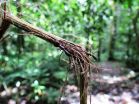New evidence of cultural diversification between neighboring chimpanzee communities
2015-07-22
(Press-News.org) For centuries it has been thought that culture is what distinguishes humans from other animals, but over the past decade this idea has been repeatedly called into question. Cultural variation has been identified in a growing number of species in recent years, ranging from primates to cetaceans. Chimpanzees, our closest living relatives, show the most diverse cultures aside from humans, most notably, in their use of a wide variety of tools.
The method traditionally used to establish the presence of culture in wild animals compares behavioural variation across populations and excludes all behavioural patterns that can be explained by genetic or environmental differences across sites. Nevertheless, it is impossible to conclusively rule out the influence of genetics and environmental conditions in geographically distant populations.
To circumnavigate this problem, researchers, led by Dr. Kathelijne Koops, took a new approach. "We compared neighbouring chimpanzee groups living under similar environmental conditions, which allows for the investigation of fine scale cultural differences, whilst keeping genetics constant," said Koops.
She and colleagues from Kyoto University and Freie Universität Berlin compared the length of tools used for 'ant-dipping' between two neighbouring chimpanzee communities, M-group and S-group, in the Kalinzu Forest, Uganda. Dipping for army ants is one of the hallmark examples of culture in chimpanzees and involves the use of a stick to extract the highly aggressive army ants from their underground nests.
Previous research has shown that ant-dipping tool length varied across chimpanzee study sites in relation to the army ant species (Dorylus spp.) that were present. So Koops compared the availability of the different species of army ants and the length of dipping tools used in the two adjacent chimpanzee communities.
The researchers found that M-group tools were significantly longer than S-group tools, despite identical army ant species availability. Considering the lack of ecological differences between the two communities, the tool length difference was concluded to be cultural. "Our findings highlight how cultural knowledge can generate small-scale cultural diversification in neighbouring groups," said Koops.
"Given the close evolutionary relationship between chimpanzees and humans, insights into what drives cultural diversification in our closest living relatives will in turn shed light on how cultural differences emerge and are maintained between adjacent groups in human societies," said Koops, who conducted the work at Cambridge University's Division of Biological Anthropology and at Zurich University's Anthropological Institute and Museum.
INFORMATION:
The research is published today in the Nature journal Scientific Reports.
ELSE PRESS RELEASES FROM THIS DATE:
2015-07-22
In their struggle to survive and prosper, multicellular organisms rely on a complex network of communication between cells, which in humans are believed to number about 40 trillion. Now, in a study published in Nature Communications, a research group led by scientists from the RIKEN Center for Life Science Technologies (CLST) has published an overall map of how the cells in the human body communicate by systematically analyzing the relationship between ligands--substances such as insulin and interferon that embody messages between cells, and receptors--the proteins on cell ...
2015-07-22
A new review published in the Cochrane Library, indicates that eradicating Helicobacter pylori bacterium-- the main cause of stomach ulcers - with a short course of therapy comprising two commonly used medicines may help to reduce the risk of gastric cancer. Stomach, or gastric, cancer is the third most common cause of death from cancer worldwide, and people who are infected with the Helicobacter pylori bacterium are more likely to develop the disease.
About two-thirds of us have H. pylori in our bodies, but in most cases we experience no discomfort or other symptoms. ...
2015-07-22
The US Family Smoking Prevention and Tobacco Control Act, passed in 2009, permits the U.S. Food and Drug Administration (FDA) to set standards for cigarette nicotine content. The FDA is accordingly supporting research into how very low nicotine content (VLNC) cigarettes might function as a regulatory measure to make cigarettes non-addictive, reduce smoke exposure, and improve public health, even among people who don't want to quit smoking.
New research published today in the scientific journal Addiction shows that simply reducing the nicotine content of cigarettes may ...
2015-07-22
New research shows that HIV treatment for illicit drug users improves their social and socioeconomic wellbeing as well as their health.
While the health benefits of antiretroviral therapy (ART) for HIV are well documented, less is known about possible secondary benefits.
Lindsey Richardson, an assistant professor in the Department of Sociology at the University of British Columbia and research scientist with the BC Centre for Excellence in HIV/AIDS (BC-CfE), presented findings from two studies July 22 at the International AIDS Society (IAS) Conference in Vancouver. ...
2015-07-22
Researchers studying wild banded mongooses in Uganda have discovered that these small mammals have either cooperative or selfish personalities which last for their entire lifetime. The findings of the 15-year study are published today in the journal Animal Behaviour.
The researchers investigated the selfish behaviour of mongoose mate-guarding - where dominant males guard particular females - and the cooperative behaviour of 'babysitting' and 'escorting' the young.
They found that cooperative mongooses that helped out with offspring care did so consistently over their ...
2015-07-22
Regular consumption of sugar sweetened drinks is positively associated with type 2 diabetes independent of obesity status, finds a study published in The BMJ this week.
Artificially sweetened drinks and fruit juice also showed a positive association with type 2 diabetes, but the quality of evidence was limited. None the less, the authors warn that neither artificially sweetened drinks nor fruit juice are suitable alternatives to sugar sweetened drinks for the prevention of type 2 diabetes.
Artificially sweetened beverages have been seen as possible alternatives to ...
2015-07-22
A low birth weight combined with an unhealthy lifestyle in adulthood are jointly related to an increased risk of type 2 diabetes, finds a study published in The BMJ this week.
The researchers say their findings emphasise the importance of adopting a healthy lifestyle to prevent the majority of type 2 diabetes cases in the population.
Diabetes has become a global epidemic, with an estimated 387 million living with diabetes and 4.9 million attributable deaths in 2014. Both unhealthy lifestyles and early life development have been implicated in the rapid rise of type 2 ...
2015-07-22
A complex web of interactions between industry, advocacy organisations, and academia may be fuelling enthusiasm for calcium and vitamin D supplements to prevent and treat osteoporosis, despite evidence of lack of benefit, warn doctors in The BMJ this week.
Calcium and vitamin D are highly profitable treatments that are widely recommended for osteoporosis, despite increasing evidence contradicting the practice, write Andrew Grey and Mark Bolland from the University of Auckland.
Several therapies previously recommended for osteoporosis, such as oestrogen and fluoride, ...
2015-07-22
Doctors and medical students in India should stop wearing white coats, argues a doctor in The BMJ this week.
Edmond Fernandes, a postgraduate at Yenepoya Medical College in Mangalore, says evidence shows that long sleeved coats spread infection and lead to avoidable harm and cost to patients.
Although long sleeved white coats have traditionally been worn by doctors since the 19th century, we now know that white coats "harbour potential contaminants and contribute considerably to the burden of disease acquired in hospital by spreading infection," writes Fernandes.
He ...
2015-07-22
Boston, MA -- People who are a low weight at birth and have unhealthy habits as adults, such as eating nutritionally poor diets or smoking, may have a greater risk of developing type 2 diabetes than people born at an average weight who live similar lifestyles, according to a new study led by researchers from Harvard T.H. Chan School of Public Health. In the first study to comprehensively assess how early development interacts with adult behavior to influence type 2 diabetes risk, the researchers found that 18% of cases were attributable to the combined effect of low birth ...
LAST 30 PRESS RELEASES:
[Press-News.org] New evidence of cultural diversification between neighboring chimpanzee communities



